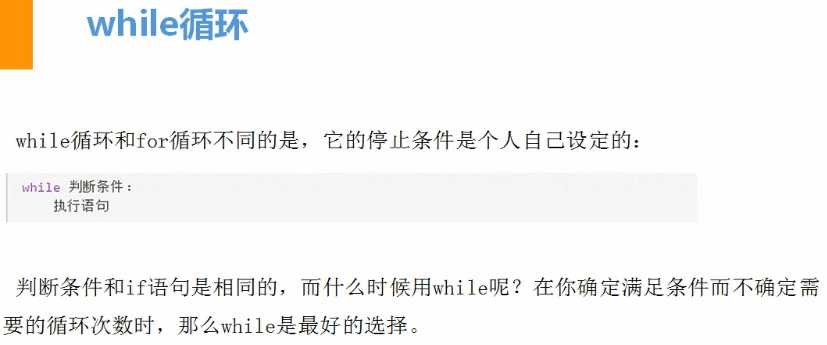Python学习while循环字符串格式运算符 编码
Posted zbhh
tags:
篇首语:本文由小常识网(cha138.com)小编为大家整理,主要介绍了Python学习while循环字符串格式运算符 编码相关的知识,希望对你有一定的参考价值。
1、while循环

使用while打印1.2.3.4.5.6.8.9.10 #快速注释Ctrl+?
count = 1 while count <= 10: if count == 7: count = count + 1 pass #表示过,不执行下面程序 else: print(count) count = count + 1 print(‘end‘)
count = 1 while count <= 10: if count != 7: #!=表示不等于 print(count) count = count + 1 print(‘end‘)
错误示例 count = 1 while count <= 10 and count != 7: print(count) count = count + 1 print(‘end‘)
关键字:break终止当前循环
continue #结束本次循环,直接开始下个循环
while True:#True首字需大写,否则报错name ‘true‘ is not defined(名称“true”没有定义) print(666) break #终止当前循环 print(‘end‘)
通过break实现1~10 while True: print(count) if count==10: break count = count+1 print(‘end‘)
while True: print(‘你好‘) while True: print(666) break
关键字:continue本次循环如果遇到continue,则不再继续下面程序,而是回到while条件位置
实现1234568910 count = 1 while count <= 10: if count == 7: count = count + 1 continue else: print(count) count = count + 1 print(‘end‘)
课外知识:(不需要记)
count = 1 while count <= 10: print(count) count = count + 1 continue else:#当不再满足while后的条件时,触发。或 条件=False print(‘else代码块‘) print(‘end‘)
count = 1 while True: print(count) if count == 10: break count = count + 1 else:#当不再满足while后的条件时,触发。或 条件=False print(‘else代码块‘) print(‘end‘)
2、字符串格式化
%s:代指字符串
%d:代指数字
#字符串格式化存在的意义 name = input(‘姓名‘) do = input(‘在干什么:‘) template = "我是%s ,%s。"%(name,do,) print(template)
template = "我是%s ,年龄%d,职业%s。"%(‘alex‘,25,‘engineer‘,) print(template)
特殊:当需要打印%时,要多加一个百分号(%%)
name = ‘alex‘ template = ‘%s手机的电量是100%%‘%(name) print(template)
name = input(‘请输入姓名:‘) age = input(‘请输入年龄:‘) job = input(‘请输入职业:‘) hobby = input(‘请输入爱好:‘) msg = ‘‘‘ ---------info of alex li-------- name: %s age: %s job: %s hobby: %s ---------end-------‘‘‘ print(msg%(name,age,job,hobby))
3、运算符
输出1-100内的所有偶数
n=1 while n<101: temp= n % 2#取模 - 返回除法的余数 if temp==0: print(n) else: pass n=n+1
求1-2+3-4+5...99的所有数的和 n=0 a=0 #a是之前所有数的总和 while n<100: print(n) temp=n%2 if temp==0: a=a-n else: a=a+n n=n+1 print(a)
Python算术运算符
以下假设变量a为10,变量b为21:
| 运算符 | 描述 | 实例 |
|---|---|---|
| + | 加 - 两个对象相加 | a + b 输出结果 31 |
| - | 减 - 得到负数或是一个数减去另一个数 | a - b 输出结果 -11 |
| * | 乘 - 两个数相乘或是返回一个被重复若干次的字符串 | a * b 输出结果 210 |
| / | 除 - x 除以 y | b / a 输出结果 2.1 |
| % | 取模 - 返回除法的余数 | b % a 输出结果 1 |
| ** | 幂 - 返回x的y次幂 | a**b 为10的21次方 |
| // | 取整除 - 向下取接近除数的整数 |
>>> 9//2 4 >>> -9//2 -5 |
Python赋值运算符
以下假设变量a为10,变量b为20:
| 运算符 | 描述 | 实例 |
|---|---|---|
| = | 简单的赋值运算符 | c = a + b 将 a + b 的运算结果赋值为 c |
| += | 加法赋值运算符 | c += a 等效于 c = c + a |
| -= | 减法赋值运算符 | c -= a 等效于 c = c - a |
| *= | 乘法赋值运算符 | c *= a 等效于 c = c * a |
| /= | 除法赋值运算符 | c /= a 等效于 c = c / a |
| %= | 取模赋值运算符 | c %= a 等效于 c = c % a |
| **= | 幂赋值运算符 | c **= a 等效于 c = c ** a |
| //= | 取整除赋值运算符 | c //= a 等效于 c = c // a |
| := | 海象运算符,可在表达式内部为变量赋值。Python3.8 版本新增运算符。 |
在这个示例中,赋值表达式可以避免调用 len() 两次: if (n := len(a)) > 10:
print(f"List is too long ({n} elements, expected <= 10)")
|
Python逻辑运算符
Python语言支持逻辑运算符,以下假设变量 a 为 10, b为 20:
| 运算符 | 逻辑表达式 | 描述 | 实例 |
|---|---|---|---|
| and | x and y | 布尔"与" - 如果 x 为 False,x and y 返回 False,否则它返回 y 的计算值。 | (a and b) 返回 20。 |
| or | x or y | 布尔"或" - 如果 x 是 True,它返回 x 的值,否则它返回 y 的计算值。 | (a or b) 返回 10。 |
| not | not x | 布尔"非" - 如果 x 为 True,返回 False 。如果 x 为 False,它返回 True。 | not(a and b) 返回 False |
# 对于or,如果遇到 value1 = 0 or 1 value2 = 8 or 10 value3 = 0 or 9 or 8 print(value) # 第一个值如果是转换成布尔值如果是真,则value=第一值; # 第一个值如果是转换成布尔值如果是假,则value=第二值; # 如果有多个or条件,则从左到右依次进行上述流程。 # 对于and,如果遇到 # 第一个值如果是转换成布尔值如果是True,则value=第二值; # 第一个值如果是转换成布尔值如果是False,则value=第一值; # 如果有多个and条件,则从左到右依次进行上述流程。 value1 = 1 and 9 value2 = 1 and 0 value3 = 0 and 7 value4 = 0 and "" value5 = 1 and 0 and 9 print(value) #综合 #先看and在看or;如果有括号先算括号内容。优先级关系()>not>and>or,同一优先级从左往右计算。 value1 = 1 and 9 or 0 and 8 print(value)
4、编码
ascii:
unicode:
ecs2
ecs4
utf-8:
utf-16:
以上是关于Python学习while循环字符串格式运算符 编码的主要内容,如果未能解决你的问题,请参考以下文章